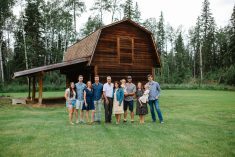Starting a new farm got a lot more practical when Shayne and Vicky Horn saw they could profit as much from their brand as from their ground
On the video blog Vicky Horn’s red hair bobs along as she pushes a baby stroller and at the same time rolls out fencing for their rotational pasturing system. It’s one image, but with it, the camera captures both the heart of the Tangle Ridge brand — pastoral family farming — and the solid core of the Horns’ business plan.
This isn’t necessarily the farm that every farm kid goes to bed dreaming about. It’s clearly on the small side, it’s built around sheep, and there aren’t any sheds crammed full of gleaming, high-horsepower machinery.
Read Also

Country Guide November editorial: The now, the next and the numbers
I must admit that when I was younger numbers mystified and frustrated me. In fact, my typically jovial grade six…
But it is a success, and the more I find out about it, the more impressed I become.
As a business, the thinking that has gone into Tangle Ridge is far from simple. There isn’t any way in which this farm’s progress has been serendipitous or arbitrary. It was planned even before Vicky and her husband Shayne bought their 160-acre farm south of Edmonton four years ago. “All we started off with was a blank quarter of land and our vision,” says Vicky.
They wanted to start farming but didn’t have the advantage of inherited assets. Instead they leveraged their own skills and an emerging market opportunity.
The Horns built their farm’s business plan around their own needs, strengths and vision, fulfilling both the soft issues and monetary needs. They wanted to use sustainable practices and have their children grow up on the farm but they also knew they would have to continue working off farm. Vicky works full time mostly from her home office and Shayne spends a day a week in the oilfield.
In 2008 the Horns started by buying 30 lambs from “hair” breeds for the 160 acres that they had purchased, seeded down and fenced a year earlier. They chose hair sheep — katahdins and dorpers — so the meat was mild. As well, the breeds are hardy and don’t require shearing.
The Horns soon decided to sell once a year at an open house on their farm near Edmonton in November, with pickup spots in Edmonton and Calgary where customers meet them. Their customers are happy to connect with the family who raised the lamb, and even happier to see the farm.
The Horns also made the strategic decision to direct market whole frozen lamb in order to minimize waste from unpopular cuts, reduce handling and eliminate retail margins, farmers’ markets and daily deliveries.
Astonishingly, it is the Horns who set their own selling price, not the retailers, market auctions, processors, and not even their customers. Tangle Ridge lamb is priced on the margins their family farm needs to survive, currently $7.50/lb. They sell whole carcasses based on carcass weight, with the total weight before it’s cut up averaging 35 to 50 pounds.
Leveraging themselves
When Shayne originally crunched the numbers, the returns in sheep production were decent and demand outweighed supply. Additionally, startup costs were lower for sheep than cattle as the handling equipment was less expensive. “Lamb was a bright spot in the industry,” says Vicky.
Vicky knew rotational grazing, and she had some experience creating a brand for local meat. She works for the renowned Alberta ranchers, the Kotelkos, who market beef under the Spring Creek Beef brand and recently linked up with XL Foods to expand their business. There, Vicky saw first hand that customers will pay extra for the story behind food.
Vicky also learned from her Spring Creek experience about the cost and complexity of certification. Instead of going for organic certification, the Horns decided to sell what they call natural lamb, grass fed and raised without antibiotics and hormones.
Organic certification is too expensive for a small farm like theirs so their customers have to trust that they don’t use antibiotics. But for the Horns, “trust” is more than a word. It’s a characteristic that they can grow and monitor. Explains Vicky: “Our brand is based on our integrity.”
Brand basics
This young couple is undeniably likable and they ooze trustworthiness. It’s a core strength, and it’s the makings of a perfect brand for food. Vicky is like a very smart Strawberry Shortcake of the sheep industry. You just want to hug her.
That’s exactly what their customers want — to connect with a local, wholesome family farm who raise meat without hormones or antibiotics. This year, only their fourth in business, the Tangle Ridge Ranch flock cannot keep up with demand and they’ve had to turn away customers.
From the beginning, Vicky knew the key to the success of their business plan was building a brand. “What we wanted was not for people to buy lamb, we wanted them to buy Tangle Ridge lamb and think that if it’s not Tangle Ridge, it’s not the same,” she says.
Instead of putting time into farmers’ markets or into elaborate, time-consuming delivery systems, the Horns focused their marketing efforts on brand development. They also decided from the beginning that it would take much more than being a nice family on a picturesque farm. The same year that they invested in their core flock, they also hired professionals to design a logo, business cards and a website (www.tangleridgeranch.ca) complete with online ordering and a blog. Now the farm is also on Twitter and Facebook.
Building the brand means vigilant use of their logo, including tagging each bag. It also means Vicky does some legwork building a local clientele of high-end independent restaurants. These restaurants feature the Tangle Ridge logo and sometimes the farm story on their menus. When Tangle Ridge lamb is the feature item at one restaurant, wait staff wear T-shirts featuring cartoon characters of their family.
This hard work paid off big time when Vicky met a reporter from the Edmonton Journal this summer while serving at a restaurant event. The reporter came out to the farm and the story was picked up by several other papers. The telephone started ringing with orders, too many to fill. “The response was amazing. I bet we instantly had 100 more customers,” says Vicky.
“We’ve met our goal of proving that in five years you can make a profitable living from a quarter section,” says Vicky.
On their farm they currently have 200 ewes and want to carry 250, which would then allow for 350 to 400 market lambs. That would boost their gross sales up to about $142,000 a year.
“As we grow closer to that goal, we’ll have to look at ways to expand beyond,” says Vicky. That could mean expanding their land base or contracting out production. Alternatively, they might have other producers join their brand, the business model used by Spring Creek.
Financing follies
To do their original land purchase they had some help from their parents but went to banks to get some operating financing. When they showed their business plan to the first bank it was ignored and the loan rejected. Eventually, they found a loans manager who read and understood their business plan and was willing to back them even though their parents weren’t farmers.
“Don’t take rejection personally. There are other options out there,” Vicky advises other farmers. “Always have a business plan to fall back on, and oh yeah, start slow.”
Having a business plan also kept them focused when they were first building fences and plowing their paycheques into the farm. “It’s the reality of starting any new business,” Vicky says. “It’s hard. No matter what business you start, you’re going to have personal sacrifices and personal money to get it going.”
Like a true entrepreneur Vicky keeps the risk in perspective. “You’re risking your family’s financial stability,” she says. “But if you keep your assets bigger than your liabilities, you can always sell it if things go bad.” CG














